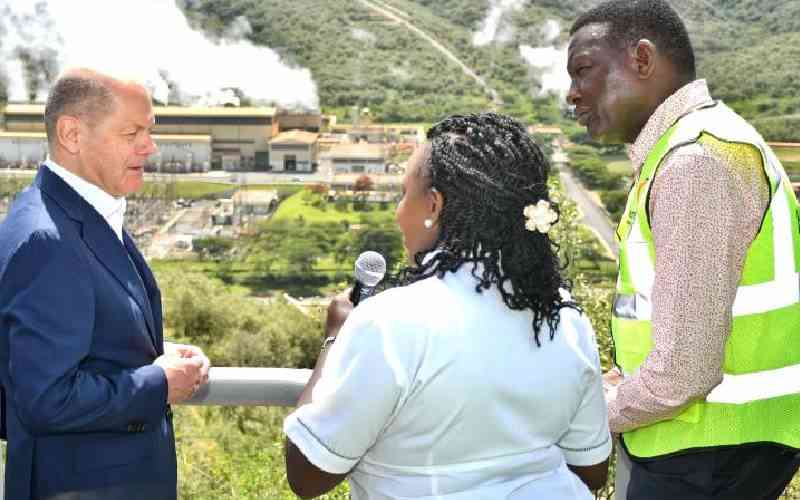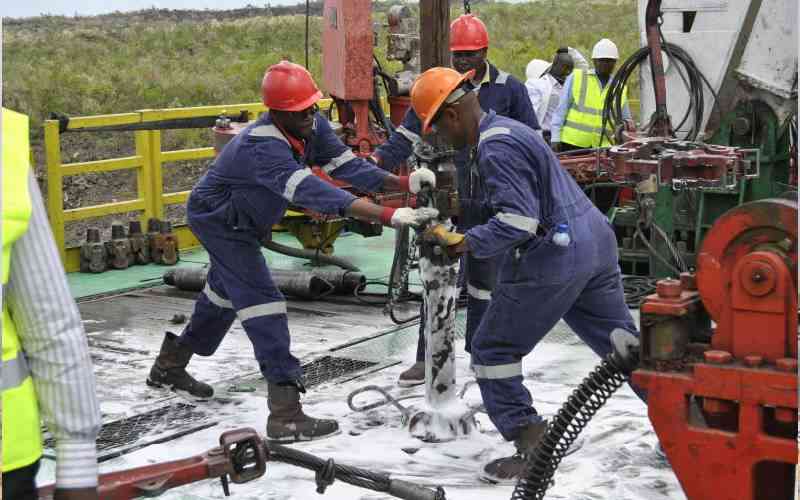President Uhuru Kenyatta and his Deputy William Ruto commissioned the Olkaria IV Geothermal Power Plant in October, marking an important milestone in the energy sector.
The occasion put a smile on Kenyans’ faces, as it reduced the cost of electricity by 30 per cent, after adding some 140 megawatts of electricity to the national grid.
President Kenyatta said the 149MW translated to 8.5 per cent of the country’s total installed capacity of 1,664 megawatts.
Another 70MW to the national grid in November, which saw the cost of electricity go down by a further 10 per cent.
The President said the renewable energy from geothermal sources was expected to reduce the country’s reliance on hydro-generated power, which accounts for 65 per cent of the total installed capacity and is prone to erratic weather patterns.
“This also means Kenya will stop relying heavily on independent power producers who use diesel to generate electricity and sell it at exorbitant prices to the Government,” he said during the commissioning of the power plant.
He noted that the overall cost of living would also come down as manufacturers were expected to lower the prices of their goods. Local manufacturers consume 60 per cent of the power produced in Kenya.
Some of the large industries in the country pay up to Sh100 million in monthly bills , which means a 40 per cent reduction in power prices will see them saving up to Sh40 million every month.
“With the reduced cost, companies will pass on the benefits to consumers, hence lowering the cost of their products,” he said.
To achieve its ambitious plan of an additional 5,000MW by 2017, the Government has promised another 61MW from the Kinangop wind power project, 300MW from the Lake Turkana wind power project, 400MW from Ethiopia, 900 from an LPG (liquid petroleum gas) power plant to be set up in Mombasa, 900MW from a coal-fired power plant in Kitui and another 1,200 MW to be generated from Menengai in Nakuru County.
However, experts in the energy sector have raised concerns about the level of power leakage normally witnessed in the country .
“Currently, Kenya loses about 20 per cent of the power produced through inefficient transmission and theft. Out of the 1,200MW produced, 360MW are lost or unaccounted for,” says Elijah Kelly, an engineer working for a local independent power producer.
In 2014, the country invited bids for the construction of two new geothermal plants as part of its plan to boost electricity production by 5,000MW in three years.
The new plants, with a capacity of 60MW, were expected be completed by the end of this year.
Increased imports
Stay informed. Subscribe to our newsletter
According to a Ministry of Energy’s 2013-2016 investment prospectus, Kenya’s geothermal generation makes up just under 250MW of the total electricity production of roughly 1,650MW.
However, with suppressed demand peaking at levels of 1,400MW, according to the ministry - and unsuppressed demand forecast to reach 1,700MW – the need to expand and diversify the power base load has become necessary.
Lower-than-expected rainfall in 2013 and 2014 added to the urgency, because it reduced the output of Kenya’s hydro-power stations.
Masinga reservoir, which feeds Kenya’s largest hydroelectric facility - the 550MW Seven Forks Dam, was at only one-third capacity by mid-2014. This prompted the country to slow exports to neighbouring countries and increase electricity imports.
Kenya is one of a handful of African countries, including Ethiopia and Zambia, exploring geothermal potential.
According to Wikipedia, the discovery of Kenya’s geothermal energy resources dates back to the 1950s, when the first test wells were drilled at Ol Karia in Nakuru County.
Kenya completed its first geothermal power plant, a 15MW facility, in 1981 at the same location.
Since then, the country has also turned to private producers, with private producers such as US-based Ormat Technologies’ 50MW plant in Olkaria contributing to geothermal production.
The World Bank estimates that geothermal energy from East Africa’s Rift Valley region could power 150 million homes.
In a move to tap into its vast geothermal energy resources, Kenya recently invited bids for the construction of two new power plants, representing another step forward in its 2017 target to boost electricity production by 5,000MW.
The two independent power producers are expected to tap into steam from the geothermal fields located in the Menegai Crater in Nakuru County.
Geothermal Development Company (GDC) chief executive Silas Simuyu said the the new plants, with a capacity of 100MW, will be completed by the end of 2015 and form one of several projects to tap into the geothermal potential that is estimated by government bodies to be as much as 10,000MW.
GDC is involved in steam exploration in Baringo County, where it set to produce 2,400MW of electricity in three phases in around eight years.
The Government created the GDC in 2006, following the passing of a new Energy Act.
The State-owned operator is responsible for upstream exploration, including drilling and surveying, as well as sourcing steam for power producers.
The National Treasury allocated Sh12.5 billion ($142 million) in the budget for the fiscal year ending June 2014 to GDC to develop and drill for steam.
GDC has also secured $120 million (Sh11 billion) from the African Development Bank and a $25 million (Sh2.3 billion) grant from Nairobi’s Scaling-up Renewable Energy Programme for the Menengai geothermal project, which is designed to produce electricity for 500,000 households.
 The Standard Group Plc is a
multi-media organization with investments in media platforms spanning newspaper
print operations, television, radio broadcasting, digital and online services. The
Standard Group is recognized as a leading multi-media house in Kenya with a key
influence in matters of national and international interest.
The Standard Group Plc is a
multi-media organization with investments in media platforms spanning newspaper
print operations, television, radio broadcasting, digital and online services. The
Standard Group is recognized as a leading multi-media house in Kenya with a key
influence in matters of national and international interest.
 The Standard Group Plc is a
multi-media organization with investments in media platforms spanning newspaper
print operations, television, radio broadcasting, digital and online services. The
Standard Group is recognized as a leading multi-media house in Kenya with a key
influence in matters of national and international interest.
The Standard Group Plc is a
multi-media organization with investments in media platforms spanning newspaper
print operations, television, radio broadcasting, digital and online services. The
Standard Group is recognized as a leading multi-media house in Kenya with a key
influence in matters of national and international interest.









